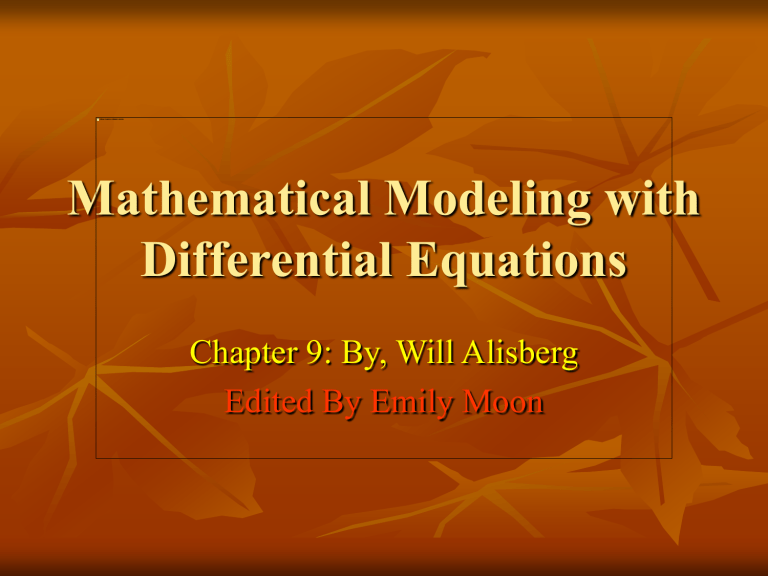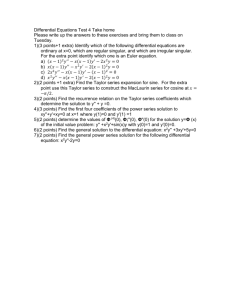Mathematical Modeling with Differential Equations

Mathematical Modeling with
Differential Equations
Chapter 9: By, Will Alisberg
Edited By Emily Moon
Overview
9.1 First-Order Differential Equations and
Applications
9.2 Direction Fields; Euler’s Method
9.3 Modeling with First-Order Differential
Equations
Quiz
Overview
9.1 First-Order Differential Equations and
Applications
9.2 Direction Fields; Euler’s Method
9.3 Modeling with First-Order Differential
Equations
Quiz
Key Definitions
Differential Equation- Any equation in which the derivative affects the f(x)… e.g. f(x)=f’(x)/(2x)
Order- the highest degree of differentiation in a differential equation
Integral Curve- Graph of a solution of a differential equation
First Order Initial Value Problems
Find a general formula for y(x) and use initial condition to solve for C.
Replace variables to solve
General Solution
Start by Converting to:
Calculate
x)
Use General Solution: dy dx
p ( x ) y
q ( x )
( x ) e P ( x ) y
1
( x )
q ( x )
My Turn!
dy dx
x
3 y
4 y dy
5 y
dx p ( x )
5 x
3 q ( x )
x
3
P ( x )
5 x
( x )
e
5 x y
So…
1 e
5 x
e
5 x
( x
3
) dx
Set up the integral for the given differential equation
Your Turn!
Set up the integral to solve for y x
2 dy dx
dy dx
x
2 y
x
1
y
Wonhee Lee
( x
2
1 )( dy dx
y )
x
1 dy
y
dx p ( x )
1 x
1
1 q ( x )
P ( x )
x
1
1 x
( x )
e x y
1 e x
e x x
1
Newton’s Second Law
Overview
9.1 First-Order Differential Equations and
Applications
9.2 Direction Fields; Euler’s Method
9.3 Modeling with First-Order Differential
Equations
Quiz
Key Definitions
Direction Field- A graph showing the slope of a function at each point
Euler’s Method- A technique for obtaining approximations of f(x)
Absolute Error- Difference between approximated value of f(x) and actual value
value of f(x), Multiply the decimal by 100 to obtain a percentage
Iteration- One cycle of a method such as Newton’s or
Euler’s
Direction Field
Show Slopes at Various
Points on a Graph
Follow the trail of lines
Different arrows with the same value of x represent different c’s
Don’t forget the points on the axes
Euler’s Method: Theory
Approximates values of f(x) through small changes in x and its derivative
The algebraic idea behind slope fields
More
x make a more accurate approximation
Euler’s Method: Calculation
Starting with a known point on a function, knowing the equation for the function.
Use y
1
y
0
f
( x
0
)(
x ) x
1
x
0
x
Repeat
Note: with very small values of
x we will get y
y
0
f
( x ) dx
Your Turn!
With a step size of
1 approximate
Knowing dy dx
3
: x x
4
Wonhee Lee y ( 1 )
4 Just kidding- Go ahead Anna y
4
3
1 .
5
1
.
75
10 .
25
Overview
9.1 First-Order Differential Equations and
Applications
9.2 Direction Fields; Euler’s Method
9.3 Modeling with First-Order Differential
Equations
Quiz
Key Defintions
Uninhibited growth model- y(x) will not have a point at which it will not be defined
Carrying Capacity- The magnitude of a population an environment can support
Exponential growth- No matter how large y is, it will grow by a% in the same amount of time
Exponential decay- No matter how large y is, it will decrease by b% in the same amount of time
Half-Life- The time it takes a population to reduce itself to half its original size
Exponential Growth and Decay
Where k is a constant, if k is negative, y will decrase, if k is positive, y will increase y
y
0 e kt
My Turn!
The bacteria in a certain culture continuously increases so that the population triples every six hours, how many will there be 12 hours after the population reaches 64000?
y
64000 e kt
3
e
6 k k
ln 3
6 y
64000 e
2 ln 3 y
576000
Your Turn!
The concentration of Drug Z in a bloodstream has a half life of 2 hours and 12 minutes. Drug
Z is effective when 10% or more of one tablet is in a bloodstream. How long after 2 tablets of
Drug Z are taken will the drug become inaffective?
Jiwoo, from Maryland
Answer
y
y
0 e kt
.
5
e
2 .
2 k k
ln .
5
2 .
2 t
.
1
2 e t (ln .
5 )
2 .
2
9 .
508
Overview
9.1 First-Order Differential Equations and
Applications
9.2 Direction Fields; Euler’s Method
9.3 Modeling with First-Order Differential
Equations
Quiz
Quiz!
1.
If a substance decomposes at a rate proportional to the substance present, and the amount decreases from 40 g to 10 g in 2 hrs, then the constant of proportionality (k) is
A. -ln2 B. -.5 C -.25 D. ln (.25) E. ln (.125)
2. The solution curve of y ( x ) y that passes through the point (2,3) is
A.
D. y e y e x x 3
( e 2
B.
3)
E. y 2 x 5 x y e
.406
C.
y .406
e x
More Quiz Questions
True or False? If the second derivative of a function is a constant positive number, Euler’s
Method will approximate a number smaller than the true value of y?
A stone is thrown at a target so that its velocity after t seconds is (100-20t) ft/sec. If the stone hits the target in 1 sec, then the distance from the sling to the target is:
A. 80 ft B. 90 ft C. 100 ft D. 110 ft E. 120 ft
Last Quiz Question
differential equation y’(x)=x with the initial value y(1)=5, then, when x= 1.2, y is approximately:
A. 5.10 B. 5.20 C. 5.21 D. 6.05 E. 7.10
1A
2C
3True
4B
5C
Quiz Answers
Bibliography
Barron’s “How to Prepare for the Advanced Placement Exam:
Calculus
Anton, Bivens, Davis “Calculus” http://exploration.grc.nasa.gov/education/rocket/Images/newto n2r.gif
http://www.usna.edu/Users/math/meh/euler.html






